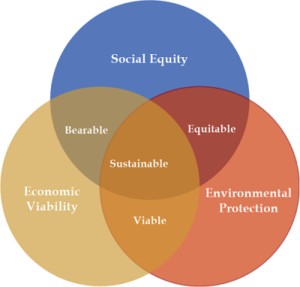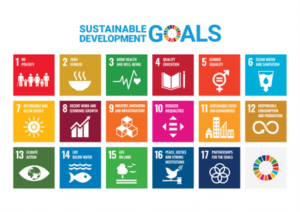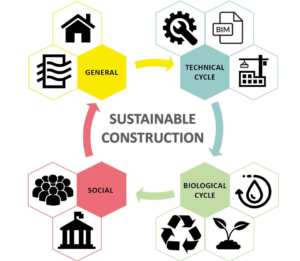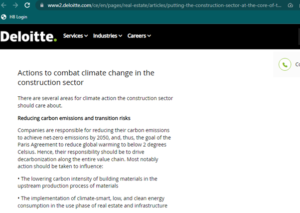A PROFESSIONAL PERSPECTIVE ON SUSTAINABILITY
Introduction
In the age of globalisation, maintaining sustainability becomes a real challenge for an individual, company as well as government as the detrimental effect of operations of human beings creates different types of hazards. On the other hand, climate change is a real threat to managing sustainability due to increasing emissions, pollution, and lack of waste management which may insecure the life of the future generation. In this report, the significance of sustainability and perspective of sustainability related to the profession and some recommendations will be discussed which support increasing awareness regarding sustainability through this report.
Definition of sustainability
Critical discussion on the theme
Sustainability includes the fulfilment of the present generation without ignoring the needs of future generations to meet their daily needs in the future while it includes maintaining a balance between social well-being, economic growth and environmental care. From research, it may be stated that the three pillars of sustainability are economic, social, and environmental and address social, ecological, and economic issues in an effective manner (Purvis et al., 2019). In recent times, there are different types of issues which provide detrimental effects on the environment and it creates ample consequences such as increasing emissions, pollution, and utilising eco-friendly materials according to the discussion in class. Ulucak et al., (2019) stated in the research that international communities have come together to find solutions against different types of climate threats such as climate change, global warming, ozone depletion, lack of biodiversity and so on. The sustainability theme covers the initiatives to minimise the current conundrums related to the environment because it damages the balance among economic profit, security for future generations and international equilibrium effectively. Considering research it may be stated that energy conservation is highly essential and solar energy helps in minimising dependence on fossil fuels (Fischer and Riechers, 2019).

Figure 1: Three pillars of Sustainability
(Source: Purvis et al., 2019)
Human actions are responsible for increasing climate hazards and in the present scenario, the responsibility of communities, corporations, and individuals is to formulate activities for overcoming the threat related to sustainability as per the diction in class. On the other hand, increasing use of technology brings several conveniences for human beings along with other companies or business operations whereas it provides an extensive range of negative impacts on the environment. According to research, it may be demonstrated that sustainability is defined as long-term goals and sustainable development provides ways of development through production, consumption, bringing awareness and many more which helps in meeting these sustainable long-term goals (Bianchi, 2020).
Meaning of sustainability
Sustainability means bringing change in the daily operation in terms of ecological balance, emissions, pollution and many more to enhance the security of the planet in the future. On a broader perspective, there are five pillars of sustainability such as a planet, people, prosperity, partnerships and peace which support increasing the ability to live by minimising the exploitation of natural resources. Vogt and Weber, (2019) articulated in the research that sustainability is difficult and complex as it is one of the challenging tasks to manage the resources and secure more options for the future generation. According to the United Nations (UN), there are 17 Sustainable Development Goals (SDGs) which help to address different issues such as climate change, inequality, poverty, peace and justice, environmental degradation and so on. The SDGs include zero hunger, clean water and sanitation, sustainable cities and communities, responsible consumption and production, climate actions and so on which need to be properly implemented to increase suitability within the operation of human beings (Sdgs.un.org, 2023). Companies along with other organisations nowadays are designing actions based on the SDGs to keep balance among different aspects such as the planet, people and profit which reflects on overall sustainability.

Figure 2: SDGs by UN
(Source: Sdgs.un.org, 2023)
The actions such as rising carbon emission, greenhouse gases, different types of pollution, increasing wastes and others become the reason behind the upliftment of 1.5°C which is noted as global warming. From a report, it may be stated that 20-40% of the international human population has faced a 1.5°C rise in temperature from 2006 to 2015 and it depicts the rapid deterioration of environmental occurrences which impacts sustainability (Ipcc.ch, 2023). Therefore, it may be stated that in the near future, following several sustainable initiatives may help to improve the present scenario and create opportunities for future generations along with the planet.
The way sustainability affects professional lives
Impact of the profession on the environment
The construction industry includes an extensive range of activities which provides a great impact on climate and fuels the issues such as extreme weather conditions, rising temperature, and rising sea levels as part of climate change. For instance, the extraction of natural resources for building construction or road construction affects the equilibrium of the environment and it also adversely affects biodiversity due to rising pollution due to various outdoor activities. Energy consumption is one of the critical factors and according to a report the construction industry consumes 36% of international energy consumption whereas building construction in China possesses 49% of energy consumption within Asian countries (Refer to Appendix 1). In addition to that, carbon emission is another detrimental impact on sustainability as 23% of carbon emission is due to construction activities and 94% of carbon emission from global construction is indirect (Huang et al., 2018). On the other hand, concrete is acknowledged as the main contributor to carbon emissions and it causes 8% of carbon emissions internationally whereas different natural disasters enhance the financial risk for building or road construction (Pourmokhtarian et al., 2022).
In recent times, advanced technologies support improving construction activities and provide solutions to maintain the sustainability of the future. One of the important technologies is Building Information Modelling (BIM) technology which helps in bringing digital transformation within engineering, architecture, and construction. Ismail et al., (2018) stated in the research that the advantages of BIM are minimising the usage of human resources, cost-effectiveness, less time-consuming, less cost-effective, improving designing, improving accuracy and many more which reflects on sustainability within a project.

Figure 3: Sustainable Construction Industry
(Source: Ismail et al., 2018)
Recommendations for sustainable practice within the construction industry
In the future, the exploitation of highly advanced technologies is required within the construction industry for sustainable practice. For example, the company needs to include Big data analytics which helps the company in demand forecasting, tracking its impact on the environment and measuring consumption. The companies in the construction industry need to follow the target of net-zero emissions by 2050 and follow the goal of the Paris Agreement to minimise global warming to below 2°C (Refer to Appendix 2). On the other hand, the technologies also provide better guidance to anticipate the risks associated with the construction project which reflects the financial prosperity. The usage of materials which consume lower energy is highly required along with the decrease in over-dependence on natural resources in the upstreaming production process. From research, it may be stated that the industrial revolution 4.0 brings a revolution within the manufacturing practices based on the technologies which provide a great impact on maintaining sustainability (Newman et al., 2021). It may be argued that a lack of action enhances the rate of 1.5% within a decade for fossil carbon emissions as well as greenhouse gas which reflects in higher energy consumption (Fawzy et al., 2020).
Companies in the construction industry should also focus on energy consumption and increasing the usage of renewable energies may help to modify the rate of energy consumption. The construction industry needs to implement a circular economy to improve its operation and maintain sustainability with the help of reused recycled material which also helps in minimising the increasing waste. The above recommendations may help the construction industry to improve sustainability and provide a better impact of the operation on society along with growth and development among the competition.
Manifesto of Prime Minister about sustainability
The initiatives based on SDGs for maintaining sustainability is one of the manifestos as a Prime Minister (PM) to secure a better future and overcome challenges. In addition to that, as PM, the inclusion of a circular economy is highly important because it helps in decreasing the carbon emission, emission of greenhouse gases along with energy consumption. From research, it may be stated that approximately 68 million people were negatively impacted and the economic losses are equal to $137 billion due to a lack of sustainability (Fawzy et al., 2020).
Responsibilities of an individual
For an individual, growing awareness regarding sustainability is highly required as it helps in enhancing the initiatives related to solubility in daily life. The huge impact of climate change should be acknowledged by an individual because human activities are conspicuously related to industrial activities, land use, waste management, energy production, deforestation and so on. Considering research, it may be stated that bringing awareness regarding the concept of connectedness to nature is highly required which supports improving the actions of human beings related to sustainability (Ives et al., 2018). It may be argued that in recent times both in developed and developing countries people are less aware of the sustainability and the adverse impact of students on the environment.
Responsibilities of a company
In recent times, the company needs to improve its operations based on the technologies and minimise the inimical effect of the operation on the environment which is directly related to sustainability. The technologies such as Artificial Intelligence (AI), Data analytics support measuring the impact of the operation along with determining the consumption of energy, carbon emission and so on. From research, it may be stated that blockchain technology ensures the tracking of data and helps in implementing a circular economy within the practice and minimises the challenges of sustainability (Upadhyay et al., 2021). On the other hand, the company needs to focus on CSR activities with the help of technologies which also help in boosting the stakeholders regarding the significance of sustainability. The technology provides the conveniences of automation which reduce the human burden of work and also supports increasing waste or land usage through different types of innovative techniques. The advanced technologies within the business activities also help in regulating the progression after the implantation of the actions or initiatives related to sustainability and measuring along with monitoring the effectiveness.
Responsibilities of a government
The government of a country has to follow the international committee’s target regarding suitability which supports enhancing the actions against environmental crisis and so on. For instance, the formulation of policies supports following the initiatives such as 17 SDGs which blueprint sustainability goals for the future generations of this planet. Apart from that, the government has to arrange different types of campaigns based on the international targets of zero-emission by 2050 which encourage every individual to boost sustainability in an effective manner. The rules and regulations based on the climate initiatives also aid the government to improve the contemporary scenario and punishment for abiding by laws creates responsibilities of maintaining sustainability. It may be argued that the lack of initiatives of governments may lead countries towards a failure of fulfilling the targets of the international committees on sustainability and worst affects existing issues such as climate change. The inclusion of a circular economy also helps the government to improve the current scenario and provides better provisions for minting sustainability or boosting sustainable practices.
Conclusion
From the above discussion, it may be concluded that sustainability is highly required and the concept covers three factors: people, planet, and profit. In the construction industry, both energy consumption and carbon emissions are really high whereas for maintaining sustainability careful steps are highly required for the future generation, the recommendations may help the companies, governance, and individuals to boost the suitability within the daily operation and overcome the challenges such as ac increasing temperature, rising sea level and many more. On the other hand, the utilisation of technologies diversely also helps the companies to obtain the goals of a net-zero emission whereas a circular economy is also an effective option for following sustainability.
References
Bianchi, G., 2020. Sustainability competences. Publications Office of the European Union.
Fawzy, S., Osman, A.I., Doran, J. and Rooney, D.W., 2020. Strategies for mitigation of climate change: a review. Environmental Chemistry Letters, 18, pp.2069-2094.
Fischer, J. and Riechers, M., 2019. A leverage points perspective on sustainability. People and Nature, 1(1), pp.115-120.
Huang, L., Krigsvoll, G., Johansen, F., Liu, Y. and Zhang, X., 2018. Carbon emission of global construction sector. Renewable and Sustainable Energy Reviews, 81, pp.1906-1916.
Ipcc.ch, 2023. Lead AuthorsMikiko Kainuma (Japan)Kristie L. Ebi (United States)Sabine Fuss (Germany)Elmar Kriegler (Germany)Keywan Riahi (Austria)Joeri Rogelj (Austria et al. (no date) Framing and context, Global Warming of 1.5 ºC. Available at: https://www.ipcc.ch/sr15/chapter/chapter-1/ (Accessed: February 23, 2023).
Ismail, N.A.A., Idris, N.H., Ramli, H., Sahamir, S.R. and Rooshdi, R.R.R.M., 2018. Sustainable BIM-based cost estimating for quantity surveyors. Chemical Engineering Transactions, 63, pp.235-240.
Ives, C.D., Abson, D.J., Von Wehrden, H., Dorninger, C., Klaniecki, K. and Fischer, J., 2018. Reconnecting with nature for sustainability. Sustainability science, 13, pp.1389-1397.
Newman, C., Edwards, D., Martek, I., Lai, J., Thwala, W.D. and Rillie, I., 2021. Industry 4.0 deployment in the construction industry: a bibliometric literature review and UK-based case study. Smart and Sustainable Built Environment, 10(4), pp.557-580.
Pourmokhtarian, A., Bakhshi, P., Bannon, Z. and Everett, B., 2022. Construction and Climate Change; Challenges and Opportunities: A Case Study of the Northeast US. In IOP Conference Series: Materials Science and Engineering (Vol. 1218, No. 1, p. 012046). IOP Publishing.
Purvis, B., Mao, Y. and Robinson, D., 2019. Three pillars of sustainability: in search of conceptual origins. Sustainability science, 14, pp.681-695.
Sdgs.un.org, 2023. The 17 goals | sustainable development (no date) United Nations. United Nations. Available at: https://sdgs.un.org/goals (Accessed: February 23, 2023).
Ulucak, R., Yücel, A.G. and Koçak, E., 2019. The process of sustainability: from past to present. In Environmental kuznets curve (EKC) (pp. 37-53). Academic Press.
Upadhyay, A., Mukhuty, S., Kumar, V. and Kazancoglu, Y., 2021. Blockchain technology and the circular economy: Implications for sustainability and social responsibility. Journal of Cleaner Production, 293, p.126130.
Vogt, M. and Weber, C., 2019. Current challenges to the concept of sustainability. Global Sustainability, 2, p.e4.
Appendices
Appendix 1


Appendix 2
Know more about UniqueSubmission’s other writing services:

